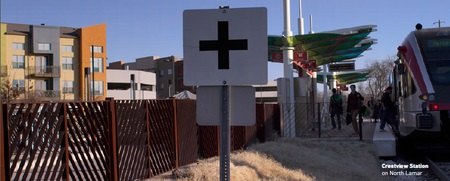Housing + Transit: Where are we going?
There is not one simple answer to the Housing + Transit equation. A rewrite of the guidelines to the Federal Transit Administration New Starts program favors comprehensive solutions. Previous guidelines rewarded projects based on the speed of travel, sometimes even when there was nothing between point A and B of the transit line. Now, applicants must show commitment to affordable housing with implemented policies and plans and economic development in a proposed transit corridor.
As Project Connect prepares to submit its New Starts application for high capacity urban transit on three corridors (Riverside, Central Core, and Highland), local governmental entities need to be proactive to create more affordable housing around the proposed transit stops. To this end, an interdisciplinary, cross departmental, collaborative Housing/Transit/Jobs Action Team was formed by Council Resolution to identify local plans and policies that support affordability, job creation, economic development, and the integration of transit. From this, the H+T+J Action Team will provide recommendations to further the vision of Imagine Austin and better align Austin’s programs and policies with the FTA New Starts Criteria. The team will report its work plan to City Council in June.
 City Council has acknowledged the H + T nexus by passing additional relevant resolutions. At City Council’s March 27 meeting, a resolution was passed directing the City Manager to develop an ordinance that reduces or eliminates parking and site area requirements for dwelling units smaller than 500 square feet (micro-units) and located on a current or future Core Transit Corridor or within an adopted Transit-Oriented Development district. Best practices and implications for adjacent neighborhoods will be examined. City Council also passed a resolution to initiate a code amendment to the “transit” criteria of the SMART Housing Program. The amendment would require a “project to be within one half mile of a transit stop, measured by the actual travel distance, at the time the project is occupied, and requiring the route from the project to the transit stop to be accessible for pedestrians and people with disabilities.”
City Council has acknowledged the H + T nexus by passing additional relevant resolutions. At City Council’s March 27 meeting, a resolution was passed directing the City Manager to develop an ordinance that reduces or eliminates parking and site area requirements for dwelling units smaller than 500 square feet (micro-units) and located on a current or future Core Transit Corridor or within an adopted Transit-Oriented Development district. Best practices and implications for adjacent neighborhoods will be examined. City Council also passed a resolution to initiate a code amendment to the “transit” criteria of the SMART Housing Program. The amendment would require a “project to be within one half mile of a transit stop, measured by the actual travel distance, at the time the project is occupied, and requiring the route from the project to the transit stop to be accessible for pedestrians and people with disabilities.”
Last month the UT Opportunity Forum and HousingWorks Austin hosted a program called “Housing + Transit: Getting on Track in Austin” to discuss the Federal Transit Administration’s New Starts Program and how to link housing, transportation and land use policies to create more sustainable and equitable communities.
Shelley Poticha, Director of the Urban Solutions Program at the Natural Resources Defense Council, emphasized the qualitative benefits of tackling the H + T equation comprehensively. Communities that provide a variety of housing types, jobs and entrepreneurial opportunities, and transportation options that really work for people and the places they need to go are more likely to be diverse, healthy and sustainable. She cited research that shows these diverse communities create higher value for their municipalities, more business and more creativity. They are places where people at all stages of life and income levels can live and have choices.
Ms. Poticha led the initiative to rewrite the New Starts guidelines with the Department of Housing and Urban Development (HUD) at the table. The FTA New Starts Program is the federal government’s primary financial resource for supporting locally planned, implemented, and operated major transit capital investments. The New Starts program funds new and extensions to existing fixed guideway transit systems including commuter rail, light rail, heavy rail, bus rapid transit (BRT), streetcars, and ferries. Applicants are ranked on a set of criteria including what plans and policies they have in place to promote affordable housing along the transit corridor.
Of the six criteria categories, two specifically address affordable housing. One looks at the proportion of “legally binding affordably restricted housing,” that is, housing within one half mile of a proposed transit station targeted to households earning 60 percent of median family income, more specifically, zero car households. Currently, 60 percent of MFI for a household of four in the City of Austin is $45,240. The other looks at policies, tools, strategies and plans to maintain or increase affordable housing in the project corridor. Affordable housing also plays a role in the rankings of two other criteria categories. In short, federal funding is very constrained and only projects that make it clear they are investing in not only transit, but also economic development, affordable housing, and improving opportunities for communities will secure New Starts funding.
Local experts , John-Michael Cortez (Capital Metro), Mandy De Mayo (HousingWorks Austin), Kyle Keahey (Project Connect), and Garner Stoll (former Assistant Director City of Austin Planning and Development Review Department), added their perspectives and insights during a panel discussion. The program can be viewed at https://www.utexas.edu/law/centers/opportunity-forum/events/housing-transit-getting-on-track-in-austin/.
The UT Opportunity Forum is an interdisciplinary collaboration of University of Texas faculty and staff working toward the expansion of equitable opportunities for low income Texans. The forum was co-sponsored by the UT Center for Sustainable Development, LBJ School Center for Politics and Governance, Capital Metro, Livable Cities, Congress for the New Urbanism, Central Texas Chapter, Imagine Austin Speaker Series, and the Austin Board of Realtors.
